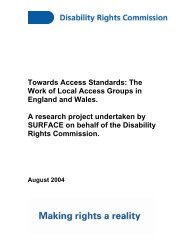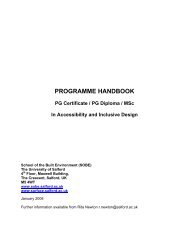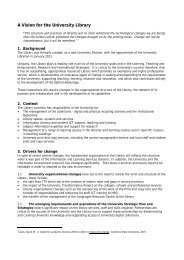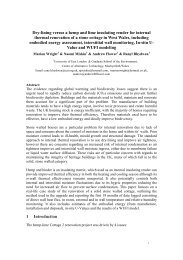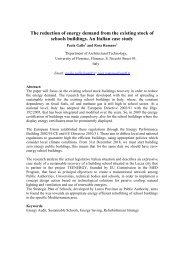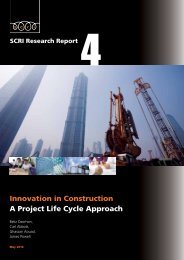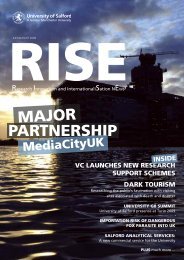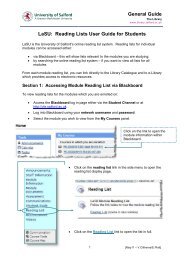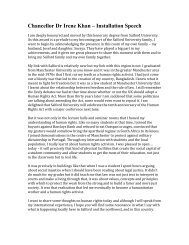RISE May-June 2009 - University of Salford
RISE May-June 2009 - University of Salford
RISE May-June 2009 - University of Salford
Create successful ePaper yourself
Turn your PDF publications into a flip-book with our unique Google optimized e-Paper software.
<strong>RISE</strong>! Research Innovation and Internationalisation News<br />
NEW FUNDING FOR<br />
FUNCTIONAL ELECTRICAL<br />
STIMULATION (FES) AND<br />
REHABILITATION ROBOTICS<br />
<strong>University</strong> <strong>of</strong> <strong>Salford</strong>’s FES research team have recently<br />
secured another research grant, worth £470,000, from the<br />
Department <strong>of</strong> Health’s i4i NEAT funding stream.<br />
DISCIPLINE HOPPING<br />
RESEARCH<br />
The <strong>University</strong> <strong>of</strong> <strong>Salford</strong> is taking part in a major new<br />
research initiative linking the Institute for Materials Research<br />
(IMR) and the School <strong>of</strong> Health Care Pr<strong>of</strong>essions (HCP), with a<br />
major discipline hopping grant from the Medical Research<br />
Council (MRC).<br />
Dr Richard D Pilkington, the senior investigator from the IMR and Gillian<br />
Cr<strong>of</strong>ts co-investigator from the HCP stated “this is a very exciting<br />
project linking the expertise <strong>of</strong> the IMR with that <strong>of</strong> the HCP”.<br />
The project will focus on the use <strong>of</strong> Laser Induced Breakdown<br />
Spectroscopy (LIBS) to look at bone density as a measure <strong>of</strong> suitability<br />
for bone assessment in dental implants.<br />
Laser Induced Breakdown Spectroscopy (LIBS) is a powerful Optical<br />
Emission Spectroscopy (OES) analytical tool capable <strong>of</strong> sampling a wide<br />
range <strong>of</strong> solids, liquids and gases for research and industrial applications<br />
and has been successfully employed in the study and identification <strong>of</strong><br />
malignant tissue cells and also to identify carious teeth. The <strong>Salford</strong> LIBS<br />
group is the only one <strong>of</strong> its type in the UK and has been studying the<br />
fundamentals <strong>of</strong> this exciting new materials analysis technique for a<br />
number <strong>of</strong> years. The research will compare results with those obtained<br />
using conventional radiographic and computerised tomography<br />
techniques. If successful, this project will lead to the development <strong>of</strong> a<br />
safe replacement for current bone analysis technologies, prior to tooth<br />
implant surgery.<br />
The project begins <strong>of</strong>ficially on the 1st <strong>June</strong> and will develop new<br />
systems for hand/arm rehabilitation after stroke based on a combined<br />
approach utilising both functional electrical stimulation (FES) <strong>of</strong><br />
partially paralysed muscles and a novel rehabilitation robotics system,<br />
using pneumatic actuation, to guide and support the arm. The project<br />
will build on the previous work <strong>of</strong> the partners who include the<br />
<strong>University</strong> <strong>of</strong> Leeds, the National Clinical FES Centre (based at Salisbury<br />
District Hospital) and Grampian NHS Trust.<br />
<strong>Salford</strong>’s FES research is led by Dr Laurence Kenney and Pr<strong>of</strong>essor David<br />
Howard (both engineers) and the team includes Christine Smith (senior<br />
lecturer and physiotherapist) and Dr Ed Chadwick (research fellow and<br />
engineer). The work is also supported by the NHS User Involvement<br />
team in the School <strong>of</strong> Nursing (Tracey Williamson and Julia Ryan). The<br />
new grant is in addition to two existing contracts, one from the<br />
Department <strong>of</strong> Health's i4i HTD funding stream to develop an electrode<br />
array system for correcting drop foot after stroke, and one from the<br />
Stroke Association for a clinical trial <strong>of</strong> FES in upper limb rehabilitation.<br />
The <strong>University</strong> currently has over £900,000 <strong>of</strong> current contracts for FES<br />
research, bringing total funding for FES research (since 2001) to over<br />
£1.5 million.<br />
FES is just one part <strong>of</strong> the cross-faculty research in "Biomedical<br />
Engineering and Biomechanics" involving the Schools <strong>of</strong> Health Care<br />
Pr<strong>of</strong>essions (HCP) and Computing, Science and Engineering (CSE),<br />
bringing cross faculty current collaborative research contracts worth<br />
approximately £2.8 million.<br />
If you want to find out more about the FES work at <strong>Salford</strong> contact:<br />
d.howard@salford.ac.uk<br />
If you would like to know more about this project contact Richard at:<br />
r.d.pilkington@salford.ac.uk<br />
7






